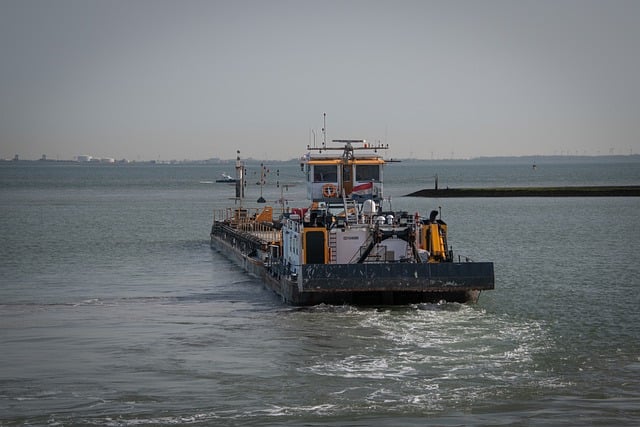Optimizing Sailing Power: Choosing the Right Boat Battery Size for Your Needs
Choosing the right boat battery is a critical decision that impacts both the functionality and safety of your sailing journey. To ensure your onboard systems, from navigation to electronics, operate efficiently, you must select a battery with an appropriate Ampere-Hour (Ah) rating that aligns with …….

Choosing the right boat battery is a critical decision that impacts both the functionality and safety of your sailing journey. To ensure your onboard systems, from navigation to electronics, operate efficiently, you must select a battery with an appropriate Ampere-Hour (Ah) rating that aligns with your vessel's power requirements and the duration of your trip. Regular maintenance is key for maintaining peak performance; this includes charging promptly after use, checking and topping off electrolyte levels in flooded cells, monitoring voltage, storing batteries properly, cleaning terminals and cables, and ensuring they are not exposed to extreme temperatures or sunlight. Proper care and attention to your boat battery's health will extend its life and ensure it performs reliably throughout your nautical adventures.
When venturing out on the open sea, the reliability of your boat battery is paramount. This article navigates the critical aspects of selecting the optimal boat battery size for your sailing needs, ensuring an uninterrupted journey. We’ll explore the essential role of these batteries in powering your navigation systems, anchoring mechanisms, and onboard comforts. Understanding the different types of boat batteries and their suitability for various sailing activities is key. By assessing your unique sailing habits and calculating the necessary power output, you can determine the right battery size to enhance your experience without compromise. Additionally, we’ll delve into the significance of ampere-hour ratings and offer maintenance tips to guarantee your boat battery serves you faithfully for years to come. Join us as we chart a course through the practicalities of powering your sailing adventure.
- Understanding the Role of Boat Batteries in Sailing
- Key Factors in Selecting the Appropriate Boat Battery Size
- The Impact of Battery Capacity on Your Sailing Experience
- Types of Boat Batteries and Their Suitability for Different Sailing Needs
- Assessing Your Sailing Habits to Determine Ideal Battery Requirements
- Calculating Adequate Power Output for Navigation, Anchoring, and Onboard Systems
- The Importance of Ampere-Hour Ratings in Boat Batteries for Sailors
- Tips for Maintaining Your Boat Battery to Ensure Long-Term Reliability
Understanding the Role of Boat Batteries in Sailing

When embarking on a sailing voyage, selecting the appropriate boat battery size is a critical decision that impacts both the functionality and longevity of your journey. Boat batteries, distinct from their automotive counterparts, are designed to handle the unique demands of marine environments. They must endure fluctuating temperatures, high humidity, and frequent discharge cycles while still delivering reliable power for navigation systems, onboard electronics, and other essential equipment. Understanding the role of these batteries is paramount as they serve as the power source during sailing when the boat’s engine is not running.
Sailors must consider factors such as the battery’s capacity, type (lead-acid, AGM, or lithium-ion), and amp-hour rating to ensure they have enough power for their intended duration at sea. The right battery size will support all onboard systems without risking depletion before reaching the next charging opportunity. For instance, a deep-cycle marine battery, such as an AGM (Absorbent Glass Mat) or lithium-ion type, is better suited for sailing due to their ability to withstand the harsh conditions and deliver consistent performance over time. Properly selecting and maintaining your boat battery ensures that you can rely on it when navigating through uncharted waters, anchoring at night, or simply enjoying the tranquility of the sea without the immediate need for engine operation.
Key Factors in Selecting the Appropriate Boat Battery Size

When embarking on a sailing voyage, selecting the appropriate boat battery size is paramount for ensuring your journey is both safe and enjoyable. The right battery will not only provide the necessary power for your electronic devices and navigation systems but also support critical operations like starting the engine and powering essential safety equipment. Key factors in choosing the optimal boat battery include understanding your power requirements, assessing the available space onboard, and considering the type of sailing you’ll be engaging in.
Firstly, calculate your total power needs by adding up the wattage of all devices you plan to use simultaneously. This will give you a clear picture of the ampere-hours (Ah) needed for a full charge. It’s crucial to opt for a battery with a higher Ah rating than your calculated need to account for partial charges and power fluctuations. Additionally, the physical dimensions of the battery must align with the available space in your boat’s storage compartments or battery boxes. Ensure that the battery is securely mounted to prevent movement during operation, which can lead to damage or reduced efficiency.
The type of sailing you undertake will also influence your choice. For instance, deep-cycle batteries are ideal for applications requiring frequent discharges and recharges, common in long-duration sailing trips. Moreover, consider the battery’s chemistry; lead-acid batteries have been traditional go-tos but are increasingly being replaced by more efficient options like AGM (Absorbent Glass Mat) or lithium batteries, which are lighter, have a longer lifespan, and perform better in extreme temperatures.
In summary, selecting the right boat battery size is a multifaceted decision that hinges on accurate power demand calculations, spatial considerations, and the nature of your sailing adventures. By carefully evaluating these factors, you can ensure your boat’s electrical system is well-equipped to handle your needs both at sea and while docked.
The Impact of Battery Capacity on Your Sailing Experience

When embarking on a sailing voyage, selecting the appropriate boat battery size is pivotal for ensuring an uninterrupted journey. Adequate battery capacity not only supports the essential navigation and communication devices but also enhances overall comfort by powering lighting, entertainment systems, and refrigeration. A boat’s energy demands vary significantly based on the duration of the trip, destination, and equipment used. For shorter excursions, a smaller battery may suffice, while long-term sailing, especially in remote areas, necessitates a larger capacity battery to handle continuous use without recharging.
The right boat battery size is crucial for several reasons. Firstly, an underpowered battery might lead to unexpected power outages at critical moments, such as when navigating through a storm or during navigation system operation. Conversely, an overly large battery might add unnecessary weight, affecting the boat’s performance and fuel efficiency. It’s also important to consider the type of battery; lead-acid batteries have been traditional choices but are increasingly being replaced by more efficient options like lithium-ion or AGM batteries due to their longer lifespan, lower self-discharge rates, and ability to operate in a wider range of temperatures. Understanding your power requirements and selecting the optimal boat battery size will ensure that your sailing experience is seamless, enhancing both safety and comfort on the open waters.
Types of Boat Batteries and Their Suitability for Different Sailing Needs

When setting sail, selecting the right boat battery is crucial for the safety and comfort of your journey. Boat batteries come in various types, each designed to cater to different sailing needs based on the nature of the voyage and the vessel’s power requirements. The two primary categories are starter batteries and deep-cycle batteries. Starter batteries, also known as cranking batteries, are designed with a higher current output for short periods, typically to start the engine. They are less suitable for prolonged discharge applications, like running electronics or GPS systems during navigation.
On the other hand, deep-cycle batteries are specifically engineered for energy storage and long-term discharge use, making them ideal for powering a boat’s electrical systems over extended periods. There are two main types of deep-cycle batteries used in marine applications: lead-acid and AGM (Absorbent Glass Mat) or gel cell batteries. Lead-acid batteries have been the traditional choice due to their reliability and affordability, but they require careful maintenance to prevent corrosion and spillage. AGM and gel cell batteries offer more stability and are maintenance-free, which makes them a preferred option for modern sailing vessels. These batteries can withstand hundreds of deep discharge cycles, ensuring consistent performance during your sailing adventure.
When choosing the right boat battery, consider factors such as the size of your vessel, the duration of your trips, the electrical load, and whether you’ll need to start the engine daily or not. For example, a cruiser with ample storage space might opt for larger AGM batteries for greater power reserves, while a smaller day-sailer may require lighter, compact options. Additionally, the battery type should align with the alternator output of your boat’s engine and the solar panels, if used, to ensure efficient charging during your voyage. Understanding the specific demands of your sailing activities will guide you in selecting the most appropriate boat battery, ensuring that you have a reliable power source to navigate safely and enjoy the full experience of sailing.
Assessing Your Sailing Habits to Determine Ideal Battery Requirements

When setting sail, the choice of boat battery size and type is a critical decision that can impact both the safety and the comfort of your voyage. To determine the ideal battery requirements tailored to your sailing habits, it’s essential to carefully assess your specific needs. Consider the duration of your typical trips, the frequency of your sailing excursions, and the electrical appliances you intend to use on board. For instance, if you frequently embark on longer voyages where self-sufficiency is key, investing in larger capacity batteries or additional battery cells might be necessary to power navigation systems, refrigeration units, and communication devices without depleting your energy reserves prematurely. On the other hand, if you are a day sailor, your requirements will likely differ, with a focus on smaller, yet reliable boat batteries that can handle short-term power needs like GPS, radio, or cabin lighting. Regardless of your sailing frequency, it’s crucial to account for unexpected circumstances where additional power may be needed, such as during extended periods of poor weather conditions where cabin lights and internal fans might be your only respite. By carefully evaluating your on-board electrical usage and planning for potential scenarios, you can select the most appropriate boat battery size that will ensure your journey is both powered and prepared for every sail.
Calculating Adequate Power Output for Navigation, Anchoring, and Onboard Systems

When embarking on a sailing voyage, selecting the right boat battery size is paramount for ensuring that all navigation, anchoring, and onboard systems function optimally. Calculating adequate power output begins with understanding the energy demands of your vessel. Each piece of equipment, from the GPS to the VHF radio, requires a specific amount of power to operate, and these needs accumulate quickly. A thorough assessment of your sailing plan is essential; consider the duration of your trip, the frequency of use for each system, and the battery’s capacity to hold a charge. For instance, during navigation, a reliable marine battery will provide the necessary voltage to maintain course and monitor position, while also powering the necessary electronics without depleting the reserves needed for anchoring or other critical operations.
Anchoring demands a significant draw on battery power, especially if holding in a strong current or adverse weather conditions is anticipated. It’s crucial to have a boat battery large enough to handle these situations without risking being adrift due to a discharged battery. Similarly, the various systems on board—from refrigeration to lighting and entertainment systems—will consistently draw power. The right battery size will ensure that these amenities can be used without compromising essential safety features or the ability to navigate or anchor when needed. Properly sizing your boat battery is not just about having enough power for comfort; it’s a strategic decision that can significantly impact your sailing experience and safety at sea.
The Importance of Ampere-Hour Ratings in Boat Batteries for Sailors

When embarking on a sailing voyage, selecting the appropriate size boat battery with accurate Ampere-Hour (Ah) ratings is paramount for ensuring your journey is powered reliably. Ampere-Hour ratings are a measure of the total electric charge that a battery can deliver over a period of one hour and are crucial in determining how long your devices, such as GPS systems, navigation lights, or autopilot systems, will function without interruption. For sailors, understanding Ah ratings allows for the estimation of power consumption for various onboard appliances, enabling efficient energy management.
Sailors must consider their boat’s electrical load and the nature of their voyage when selecting a boat battery. Heavy loads may necessitate batteries with higher Ah ratings to provide sustained power output throughout the expedition. For instance, longer voyages or those that require frequent use of power-intensive equipment like refrigeration systems or communication devices, will demand batteries with sufficient capacity to meet these energy demands. In contrast, shorter trips with light electrical usage might allow for a smaller battery size without compromising on reliability. Nevertheless, regardless of the voyage’s length, the right boat battery, matched with precise Ah ratings, is an essential consideration for sailors who value safety and comfort during their nautical adventures.
Tips for Maintaining Your Boat Battery to Ensure Long-Term Reliability

When it comes to maintaining your boat battery, ensuring long-term reliability is paramount for uninterrupted sailing adventures. Regular maintenance can significantly extend the lifespan of your boat battery and prevent unexpected failures at sea. Firstly, consistent charging is crucial; always recharge your battery after each use, ideally within 24 hours, to maintain its optimal state of charge. This helps to preserve the battery’s capacity and prevent sulfation, a process where sulfur crystals form on the lead plates, reducing efficiency over time.
Additionally, regularly checking and topping off the water levels in flooded-cell batteries is essential for their performance. The specific gravity of the electrolyte solution should be between 1.265 and 1.295; if it falls below 1.230, you should add distilled or deionized water to bring it back to safe levels. Monitoring the battery’s voltage during discharge will also inform you of its health. A properly functioning boat battery should not drop below 50% of its charge before protection mechanisms engage. Lastly, store your boat battery in a cool, dry place, away from direct sunlight and extreme temperatures, to prevent degradation. Regular cleaning of the terminals and cables with a mixture of baking soda and water, followed by a rinse with clean water, will keep the connections corrosion-free and ensure optimal conductivity. By following these tips, you can guarantee that your boat battery is ready for every sailing expedition and maintain its performance over the long haul.
When embarking on a sailing journey, selecting the right boat battery size is pivotal for a seamless experience. This article has illuminated the importance of understanding your specific sailing needs and how they correlate with battery capacity. Factors such as your vessel’s power consumption patterns, navigation requirements, and onboard systems all play a role in determining the optimal battery size. By considering the types of batteries available and their suitability for different sailing activities, you can ensure that you have adequate power output when it matters most. Ampere-hour ratings emerge as a critical specification for predictable battery performance, which is essential for prolonged sailing trips. Moreover, maintaining your boat battery with the right care and attention will help to guarantee its longevity and reliability. In essence, the right boat battery is not just an accessory but a cornerstone of a successful sailing excursion, ensuring that every voyage is powered by dependable energy.







